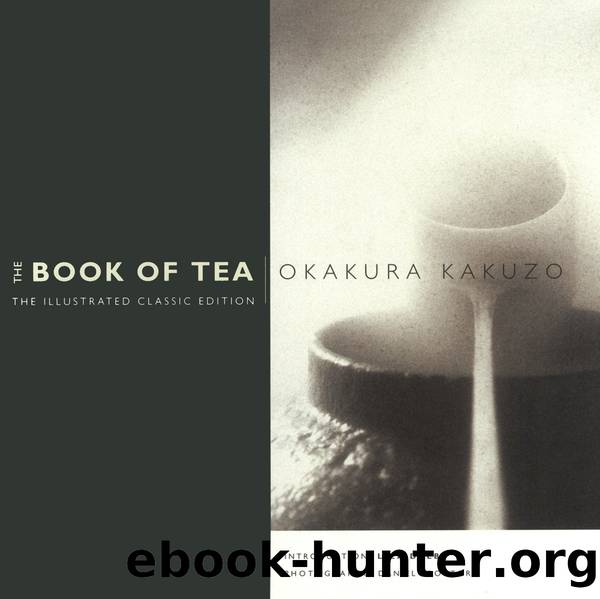The Book of Tea: The Illustrated Classic Edition by Okakura Kakuzo

Author:Okakura Kakuzo [Kakuzo, Okakura]
Language: eng
Format: epub
ISBN: 0-8048-3219-6
Published: 0101-01-01T00:00:00+00:00
Others, like Kobori-Enshiu, sought for a different effect. Enshiu said the idea of the garden path was to be found in the following verses:
"A cluster of summer trees,
A kit of the sea,
A pale evening moon."
It is not difficult to gather his meaning. He wished to create the attitude of a newly-awakened soul still lingering amid shadowy dreams of the past, yet bathing in the sweet unconsciousness of a mellow spiritual light, and yearning for the freedom that lay in the expanse beyond.
Thus prepared the guest will silently approach the sanctuary, and, if a samurai, will leave his sword on the rack beneath the eaves, the tea-room being pre-eminently the house of peace. Then he will bend low and creep into the room through a small door not more than three feet in height. This proceeding was incumbent on all guests,âhigh and low alike,âand was intended to inculcate humility. The order of precedence having been mutually agreed upon while resting in the machiai, the guests one by one will enter noiselessly and take their seats, first making obeisance to the picture or flower arrangement on the tokonoma. The host will not enter the room until all the guests have seated themselves and quiet reigns with nothing to break the silence save the note of the boiling water in the iron kettle. The kettle sings well, for pieces of iron are so arranged in the bottom as to produce a peculiar melody in which one may hear the echoes of a cataract muffled by clouds, of a distant sea breaking among the rocks, a rainstorm sweeping through a bamboo forest, or of the soughing of pines on some faraway hill.
Even in the daytime the light in the room is subdued, for the low eaves of the slanting roof admit but few of the sun's rays. Everything is sober in tint from the ceiling to the floor; the guests themselves have carefully chosen garments of unobtrusive colours. The mellowness of age is over all, everything suggestive of recent acquirement being tabooed save only the one note of contrast furnished by the bamboo dipper and the linen napkin, both immaculately white and new. However faded the tea-room and the tea-equipage may seem, everything is absolutely clean. Not a particle of dust will be found in the darkest corner, for if any exists the host is not a tea-master. One of the first requisites of a tea-master is the knowledge of how to sweep, clean, and wash, for there is an art in cleaning and dusting. A piece of antique metal work must not be attacked with the unscrupulous zeal of the Dutch housewife. Dripping water from a flower vase need not he wiped away, for it may he suggestive of dew and coolness.
In this connection there is a story of Rikiu which well illustrates the ideas of cleanliness entertained by the tea-masters. Rikiu was watching his son Shoan as he swept and watered the garden path. "Not clean enough," said Rikiu, when Shoan had finished his task, and bade him try again.
Download
This site does not store any files on its server. We only index and link to content provided by other sites. Please contact the content providers to delete copyright contents if any and email us, we'll remove relevant links or contents immediately.
The Tales of Beedle the Bard by J.k.rowling (eng)(2364)
Fable: A Novel by Adrienne Young(1142)
The Ickabog by J. K. Rowling(1125)
Ghost Drum: Book 1 of The Ghost World Sequence by Susan Price(1115)
Fantastic Beasts and Where to Find Them: Illustrated Edition by J. K. Rowling & Newt Scamander(995)
The Silvered Serpents by Roshani Chokshi(846)
Wings of Fire Graphic Novel #4 by Tui T. Sutherland(691)
The Lion King by Disney Book Group(679)
Champion: The Graphic Novel (Legend) by Marie Lu(646)
Magnus Chase The Sword of Summer by Rick Riordan(640)
The Tombs of Atuan by Ursula K LeGuin(638)
Sweet & Bitter Magic by Adrienne Tooley(615)
The Hero by Amelia Shea(588)
The Alchemyst (The Secrets of the Immortal Nicholas Flamel Book 1) by Michael Scott(573)
Heroes of Olympus Book 1 - The Lost Hero by Rick Riordan(499)
Tales From Earthsea by Ursula K. LeGuin(470)
Trouble in the Stars by Sarah Prineas(463)
Grandparents' Bag of Stories by Sudha Murty(436)
Mary Pope Osborne - Magic Tree House 18 by Buffalo Before Breakfast(434)
